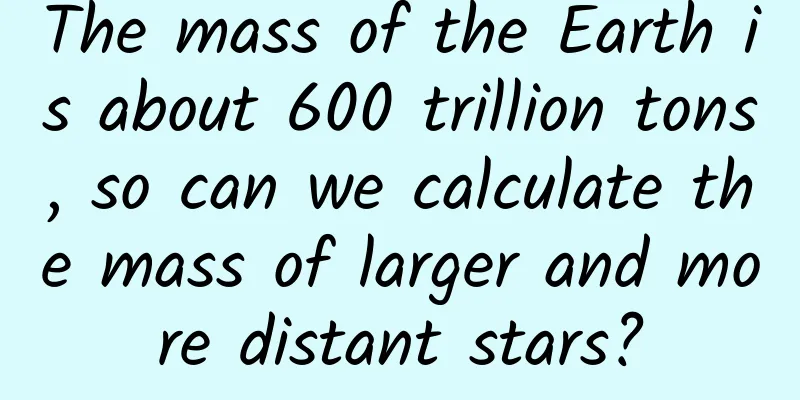The mass of the Earth is about 600 trillion tons, so can we calculate the mass of larger and more distant stars?

|
The mass of the Earth is 5.965x10∧24 kilograms, which is approximately equal to 600 trillion tons. Whenever this is mentioned, there will always be people who have questions: "The Earth is so big, how do we know its mass?" The reason why we know the mass of the Earth is that two scientists told us, one is Newton and the other is Cavendish. Newton discovered the universal gravitation and proposed the universal gravitation formula, that is, F=G(m1m2/r∧2). Any two objects with mass have mutual gravitational force. For example, we can stand on the ground with our feet firmly on the ground because of the gravity of the earth, and the magnitude of this gravity is F, which is 9.8N/kg. m1 and m2 represent the masses of the two objects respectively. In the above example, m1 is the Earth, and m2 is ourselves. As for r, of course, it is the radius of the Earth. In the formula of universal gravitation, G represents the gravitational constant. In Newton's time, people had not found a way to measure the gravitational constant. So even though they had the formula of universal gravitation, there was no way to calculate the mass of the earth until Cavendish appeared. Cavendish invented a simple and interesting experimental device called a "torsion balance". The main body of this experimental device is actually a wooden stick, two small balls and a thin wire. Cavendish used such a device to accurately measure the gravitational constant of 6.754x10∧-11. Knowing the gravitational constant, it is easy to calculate the mass of m1, that is, the mass of the earth, using the universal gravitation formula. The result is 5.965x10∧24 kilograms, about 60 trillion tons. The mass of the Earth can be easily calculated using the law of universal gravitation. So if it is a star that is much larger than the Earth, such as the Sun, can we also calculate its mass? Of course it is possible, but this time it is not enough to use only the universal gravitation formula, because we can only determine the radius of the sun through observation, but there is no way to go to the sun to measure the gravitational acceleration. What should we do? At this time, we need to use another formula. This formula is the Kepler formula, that is: m1+m2=(4π∧2/G)(R∧3/P∧2). In this formula, m1 is the mass of the earth, m2 is the mass of the sun, G is still the universal gravitational constant, R is the orbital radius of the earth, that is, the average distance between the earth and the sun, and P is the orbital period of the earth. In this formula, the only unknown number is the mass of the sun, so we can calculate it. The mass of the sun calculated using Kepler's formula is 1.989x10∧30 kilograms, which is 330,000 times the mass of the earth. This formula can be used to calculate not only the mass of the sun, but also the mass of other celestial bodies. How can Kepler's formula be used to calculate the mass of other celestial bodies? You must have such a question in your mind, because we can use Kepler's formula to calculate the mass of the sun because we know the mass of the earth, but for other celestial bodies, the mass of the earth cannot be used. Take Mars as an example. It has two satellites, Phobos and Deimos. If we want to use Kepler's formula to calculate the mass of Mars, we can choose one of Phobos and Deimos at will. Let's assume that we choose Phobos. To use Kepler's formula to calculate the mass of Mars, we must know the orbital radius of Phobos, the orbital period of Phobos, and the mass of Phobos. The orbital radius and orbital period of Phobos can be obtained through observation, but the mass of Phobos is unknown. However, it doesn’t matter if we don’t know it, because when calculating the mass of the sun, if we don’t know the mass of the earth, it will not affect the result of the calculation at all. Because the earth is too small compared to the sun, its mass can be almost ignored. Similarly, Phobos is too small compared to Mars, and its mass can also be ignored, so when calculating, we can assume that the mass of Phobos is zero, so that the mass of Mars can be calculated. We can use Kepler's formula to calculate the celestial bodies in the solar system. But if a star is very far away from us, tens or even hundreds of light years away, and there are no planets orbiting around it, how can we calculate its mass? There is a way. We can also know its mass by observing its luminosity. How to know it? Simply put, it is to compare the luminosity of a star with the luminosity of the sun. So what is the relationship between the luminosity and mass of a star? The formula is as follows: L (stellar luminosity) / L (solar luminosity) = (M (stellar mass) / M (solar mass)) ∧ 3.5. The luminosity of a star, the luminosity of the sun, and the mass of the sun are all known, so naturally we can know the mass of the star. For more information, please follow the official account: sunmonarch |
<<: If you are losing weight, please keep this good news
Recommend
Extending the break time between primary and secondary schools in Beijing from 10 minutes to 15 minutes will have what benefits for students’ physical and mental health?
On August 30, the reporter learned from the Beiji...
Lua 5.3.0 RC2 released
[[125071]] Lua 5.3.0 RC2 is now available for dow...
Moving forward in the cracks: the mobile game market under the new audit policy
Developers in the fog Li Jianhua is the head of a...
Life in space has many restrictions. How should astronauts maintain their mental health?
On August 13, 2021, Russia's TASS news agency...
Extremely effective operation skills in headline information flow!
Hello everyone, today I will mainly share two top...
A glimpse into the current status of VR game development at home and abroad: Are we falling behind this time?
Last Friday, a developer forum themed on VR games...
BlackBerry Priv review
On November 13, BlackBerry held a new product lau...
Why can't cities be without trees?
March 12, 2022 is the 44th Arbor Day. Let's p...
Aiti Tribe Stories (31): How to become a qualified network engineer?
[51CTO.com original article] Perhaps many people ...
5 reasons for poor execution and how to solve them
When communicating with CEOs of foreign companies...
5 steps to make your Douyin operation more efficient
If you ask Aunt Lisa, does it cost money to make ...
Why are the giants still flocking to autonomous driving despite frequent accidents?
The birth of every cutting-edge technology is ins...
iOS source code: annual calendar showing events
Functional classification: Life Supported platfor...
The seven deadly sins of iPhone 6s
It has been almost a month since the new iPhone 6...
Great Wall plans to invest US$500 million to build a factory in Mexico
According to a recent report from the UK, Great W...









